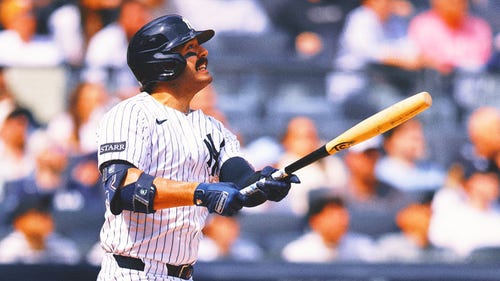
Blue Jays catcher Russell Martin has a strikeout problem
Toronto Blue Jays catcher Russell Martin has struck out a whopping 141 times this year, which isn’t just a career high, it’s roughly a 30 percent increase over his previous career high. His strike out rate currently stands at 28.7 percent, also easily a career high.
When a 33 year old catcher suddenly starts striking out at a much higher rate, it sets off red flags. However, in Martin’s case, the strike outs do not seem to be significantly effecting his overall offensive production.
Martin is slashing .236/.332/.416 with a 98 OPS+ in 2016 which is below his 2015 levels or production but not out of line with the rest of his career. From 2006-2013 Martin put up a 99 OPS+, batting .255/.349/.396. For his career overall, he is hitting .255/.350/.406 with a 103 OPS+. That puts 2016 well within the normal range.
His slash line holds up for three different reasons. First, martin is still maintaining a 11.0 percent walk rate, which is in line with his career average. Secondly, he continues to hit for extra bases, putting up a .180 ISO, the third highest of his career. And his .300 BABIP–a tick above his career .287 mark, but not abnormal–has kept his batting average from approaching Mario Mendoza levels. Sub in his 2015 batting average on balls in play and he’d only be hitting .210.
A disastrous April is partially at play here – after his first 67 plate appearances, Martin was the not so proud owner of a 46.3 percent strike out rate. Yes, that decimal is actually in the right place – 31 strike outs in 67 PA. His slash line suffered, as you’d expect from someone who can’t make contact – .105/.224/.167 with one extra base hit. For perspective, pitchers as a whole are hitting .132/.164/.171 this year. So that’s bad.
Martin has straightened himself out since then, hitting a respectable .251/.349/.457 in 425 plate appearances after May 1st. So that’s that, right? One really bad month threw everything off and he’s been fine since? Well…not so much.
In those 425 PAs, Martin has also struck out 110 times, a 25.8 percent rate. That is still well above his career number. He has eclipsed his overall career strike out rate in every individual month this season:
April: 46.3 percent
May: 21.1 percent
June: 25.0 percent
July: 25.0 percent
August: 25.7 percent
September: 35.4 percent
CAREER: 17.4 percent
May was the only month that even came close to approaching Martin’s career average and even that is almost 4% above it. This wasn’t a one month blip on the radar – his entire season has been a whiff-fest.
More from Statliners
According to PITCHf/X, Martin hasn’t been chasing more pitches. His swing rate stands at 39.3 percent, actually below his 40.5 percent career rate. That isn’t a massive change, and he isn’t swinging at worse pitches, either–his swing percentage on pitches outside the zone is also below his career numbers. What has decreased, obviously, is his overall contact rate.
It is currently a career low 71.8 percent, where his career rate is 79.8 percent. Even if his abysmal April is removed from the equation, he is still only making contact 73.4 percent of the time. That’s a huge drop.
What is odd is that such a large decrease isn’t manifested anywhere else. There are a few reasons for strikeout rates to jump, but they have other side effects. For example, if a hitter has lost bat speed, he might start his swing earlier. This leads to more swings and misses, as the hitter has to commit to bad pitches before realizing that they won’t be over the plate. Yet Martin doesn’t have an increased swing rate and his walk rate has remained high. A slower bat could also lead to weaker contact, but nothing in Martin’s batted ball profile indicates that this is happening on any significant level.
Another possibility is that he is trying to hit for more power. Hitters can end up striking out more often if they are making an effort to hit more diners, but Martin doesn’t seem to be showing a significant power boast. His ISO is above his career average but not to a crazy degree.
Want your voice heard? Join the Statliners team!
A third possibility is poor pitch recognition. If a batter think he is getting a fastball but he is really getting a slider, he’s not going to have much luck. But this would likely not be contained to strike outs. A hitter that can’t properly recognize pitches will strike out a lot, but his other stats should also drop significantly – less walks, weaker contact, etc.
Perhaps in Martin’s case it’s a combination of factors, stemming mainly from age. It is entirely possible that the 33 year old has lost a little bit of bat speed and has decided to largely give up on good contact rates in exchange for still generating some power. When he decides to swing, he’s swinging hard and hoping for the best. This would lead to a higher SLG%, except for the fact that, again, he’s a 33 year old catcher. He really shouldn’t have a ton of power left, so maybe this actually is old-man-Martin’s version of generating more power.
Of course, that’s just speculation. It could be something else. Maybe he’s battling a nagging injury, maybe he’s tinkering with his swing in a few different ways, or maybe this entire season is just a statistical anomaly. Any of those are possible. But one thing is for sure: The Toronto Blue Jays owe Russell Martin $60 million over the next three seasons. If this is the early signs of age related decline, there are going to be a lot of sad faces north of the border by 2019.
This article originally appeared on




